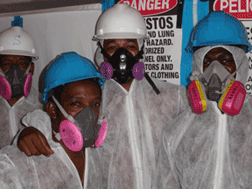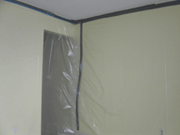
Are you interested in or concerned about the possibility of asbestos in your home ? Is the information you generally find geared towards contractors and builders and little too technical or in-depth? Below are some general questions and answers about asbestos, what it is, where it is found, and health risks and how you can avoid them.
1. What is asbestos?
Asbestos is the common name for a group of naturally occurring mineral fibers that are known for their strength and their insulating properties. It is commonly found in a variety of building construction materials and products, for example:
- Heating system insulation

- Spray-applied insulation
- Vinyl sheet flooring
- Ceiling tiles
- Adhesives and construction mastics
- Roofing paper and shingles
- Cement siding shingles
- Plaster and joint compound
- Vermiculite (often used in fireproofing and insulation)
2. Why is asbestos a problem?
Asbestos is found in 3,400 different products under various names. When asbestos is disturbed, it can break down into microscopic fibers that may become airborne. Once airborne, these fibers can be inhaled and become trapped in the lungs, posing a health threat. Breathing asbestos can cause respiratory diseases, including asbestosis; lung cancer; and mesothelioma, a fatal cancer of the chest cavity lining.
3. How should asbestos be handled to minimize the health risks?
The greatest potential for exposure to asbestos occurs when building materials containing asbestos are disturbed - usually during renovations and demolitions. All building owners should be aware of what steps need to be taken to properly identify and address any potential asbestos issues prior to beginning any work that may disturb asbestos-containing materials.
4. What should I do with asbestos in my home?
Many homeowners have asbestos-containing materials in their homes. In order to properly identify these materials, homeowners should have an Asbestos Survey performed by a Florida Licensed Asbestos Consultant (FLAC) prior to any renovations or demolitions. Any asbestos-containing material that is in good condition and will not be disturbed should be left alone.
If asbestos-containing materials in the home are in poor condition or are going to be disturbed duringrenovation or demolition, they should be removed. Homeowners in a single-family residential home (not for commercial purpose) may do the work themselves, provided they are not selling the home within twelve (12) months. All asbestos-containing materials must be properly packaged and disposed of properly. Homeowners should use extreme caution when dealing with asbestos-containing materials, and should consider using a licensed asbestos contractor for all removal projects.
Asbestos Avoidance Checklist
- Do not carry out any projects on Asbestos-Containing Materials (ACM)

- Do not disturb ACM by banging nails into it
- Do not drill into ACM
- Do not scrape or use a steam stripper on ACM
- Do not attempt to remove any ACM
5. What is RACM?
Regulated Asbestos-Containing Material, also known as RACM, is a material that contains asbestos in quantities greater than 1% and can be crumbled, pulverized, or reduced to powder by hand pressure when dry (friable); or former non-friable ACM that has lost its structural integrity by natural or mechanical force. These materials become regulated if more than 160 square feet, 260 linear feet, and/or 35 cubic feet of off-facility components are planned to be disturbed during a renovation or demolition project.
Some examples of RACM are:
- Spray acoustic ceilings
- Duct wrap
- Paper backing of linoleum
- Wallboard
- Thermal insulation of pipes and boilers
The use of asbestos in the manufacturing of these products was banned in 1978, but some products were still on the shelf and were used in the construction of homes and buildings for years after.
Non-friable asbestos-containing material is typically bound with cement, vinyl, asphalt or some other type of hardening binder. Some examples of non-friable asbestos building products are:
- Transite (cement) siding
- Vinyl asbestos floor tiles
- Asphalt roofing shingles
This material can become friable if it is pulverized during renovation or demolition.
6. What if my home is damaged from a hurricane or a storm?
The U.S. EPA recommends that if you know or suspect that your home contains asbestos and any of these materials have been damaged or will otherwise be disturbed during cleanup, seek the assistance of public health authorities and try to obtain help from specially trained contractors, if available. Asbestos containing materials can include the following:
For more information regarding asbestos, please visit our Asbestos Program web page or the Asbestos Regulations Frequently Asked Questions
